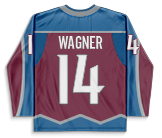
NHL Hockey Player News


Chariter has failed to pick up a point in six straight contest and was placed on waivers Tuesday by the Ottawa Senators. The 27-year-old has struggled for the Senators offensively all season, with only two goals, three points, 14 PIMs and a -3 plus/minus in 34 games played. He is expected to report to Belleville (AHL) if he clears waivers.

It was reported yesterday by Elliotte Friedman that Beaudin was unhappy with his AHL minutes in Laval (AHL) and has agreed to mutually part ways with Montreal. The 24-year-old defensemen was Chicago's 2018 first round pick (27th overall) and has struggled with Laval this season, producing only six assists, six PIMs and a +2 plus/minus in 16 games prior to the mutual parting.

Shore has two points (2A) in his previous 15 contests and has been placed on waivers Monday by Seattle ahead of the All-Star break. The 29-year-old has struggled offensively in his first season in Seattle, with only four points (1G/3A), 15 SOG and four PIMs in only 21 games played.

Chisholm was placed on waivers Sunday by Winnipeg and claimed Monday by the Minnesota Wild. The 24-year-old has a one-year, $775,000 contract and has appeared in two games for the Jets this season, collecting one assist, and a +1 plus/minus.

Ruzicka had been held without a point in 10 straight games and was a healthy scratch for the Calgary Flames on Tuesday before being placed on waivers the following afternoon. The 24-year-old Slovak was the fourth-round pick of the Flames in the 2017 NHL Entry Draft. He has 40 points (14G / 26A) in 114 career games with the Flames.

DeSimone was a healthy scratch for the last five games for the Calgary Flames and was placed on waivers on Wednesday. The 29-year-old defenseman has five points (1G / 4A), 19 shots, 12 hits, and 21 blocks in 23 games this season.


DeSimone has been a healthy scratch the last two games and was placed on waivers by the Flames on Wednesday. The 29-year-old defenseman has five points (1G / 4A), 19 shots, 12 hits, and 21 blocks in 23 games this season.

Ruzicka has been held without a point in 10 straight games and was a healthy scratch on Tuesday against the St. Louis Blues. The 24-year-old Slovak was the fourth-round pick of the Flames in the 2017 NHL Entry Draft. He has 40 points (14G / 26A) in 114 career games with the Flames.

Stephens has been placed on waivers and will report to the Laval Rocket of the AHL if he goes unclaimed. The 26-year-old has three points (2G / 1A) while averaging 9:03 time-on-ice through 23 games this season.

The Oilers have placed Erne on waivers, a move likely made to help make room for the addition of Corey Perry. Erne has struggled to establish himself in the Oilers roster this season, being limited to only two points (1G / 1A) in 23 games.

Martin will add some depth to an uncertain Hurricanes crease after being claimed off waivers from the Blue Jackets. Pyotr Kochetkov (concussion) and Frederik Andersen (blood clot) are both currently sidelined for the Hurricanes, though Kochetkov's return to the lineup seems imminent. Martin last played on January 2nd, allowing four goals on 27 shots (.852 SV%) in a 4-1 loss to the Boston Bruins, a fair representation of his seasonal 3.65 GAA and .887 SV%.

With the Blue Jackets' crease seemingly belonging to Daniil Tarasov, the Blue Jackets have placed Spencer Martin on waivers. Martin last played on January 2nd, allowing four goals on 27 shots (.852 SV%) in a 4-1 loss to the Boston Bruins, a fair representation of his seasonal 3.65 GAA and .887 SV%.

Duehr has semi-regularly been a fixture in the Flames lineup this season but has been placed on waivers Wednesday afternoon. In 19 games this season, Duehr has four points (1G / 3A) and 25 hits while averaging 7:58 time-on-ice.

The 32-year-old Wagner has not played a single game this season and will report to the Colorado Eagles of the AHL if he clears waivers. Last season with the Providence Bruins (AHL), Wagner scored 31 points (19G / 12A) in 62 games.

Lindstrom was dealt to Montreal in the offseason alongside a 2025 fourth-round pick for Jeff Petry but has struggled to find his footing in his first season with the Canadiens and will now join the Anaheim Ducks after being claimed from waivers on Wednesday. The 25-year-old carries a $950,000 cap hit and had three goals, an assist, 15 SOG and six PIMs in 14 games played before his waiving.

Lindstrom was dealt to Montreal in the offseason alongside a 2025 fourth-round pick for Jeff Petry but has struggled to find his footing in his first season with the Canadiens' and was placed on waivers Tuesday. The 25-year-old carries a $950,000 cap hit and had three goals, and assist, 15 SOG and six PIMs in 14 games played prior to his waiving.

Rooney had an assist, 14 SOG, seven PIMs and a -2 plus/minus through 17 games played with Calgary in 2022-23 but has been forced to miss all of the 2023-24 season thus far as he remains out of the lineup from off-season shoulder surgery.
